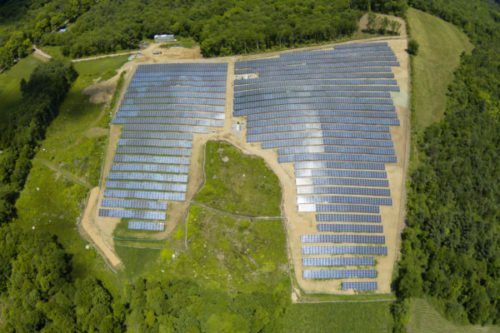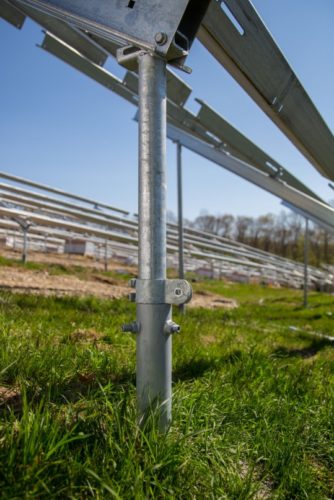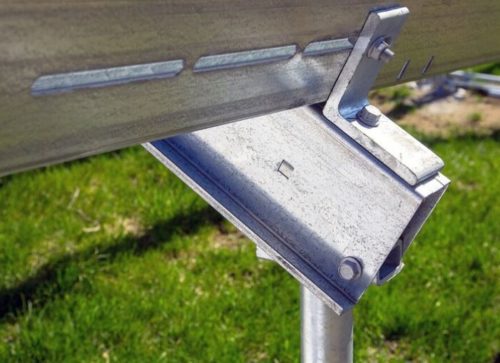
With more solar mounting systems using smart engineering features, projects can be completed on terrains once thought unmanageable. One site is a 3.6-MW project in North Brookfield, Mass., with a 25-degree tilt angle, sitting on subsurface rock in a hilly and forested area of the state.(Photo By: Greg M. Cooper / Borrego Solar)
By the engineering team at TerraSmart
Despite best efforts and geotechnical reports, solar ground mount projects often encounter unforeseen conditions. Without a way to quickly mitigate this challenge, a project risks halting production, reducing racking precision, inflating budgets and time-consuming change orders. As a result, we’ve seen more EPC’s and solar developers now choosing foundation and racking systems that have proven to be more flexible for in-field installation teams working with steep slopes, subsurface rock and soil conditions that commonly meet with refusals.
Built-in contingency features
Smart engineering has led to the development of built-in contingency features in top-of-the-line mounting systems. Built-in contingency features include advancements in setting precision ground screw foundations on tough terrain, the fabrication of flexible and adjustable racking connection points, simplified hardware stacks and more. Because of these features, the risks to project timelines are dramatically decreased and more project bids are won.
Best of all, this is done without the added expense and time of sinking concrete, due to the exponential growth of ground screw foundations set with next generation installation equipment, such as Trimble integrated rock drills that monitor depth and location with real-time GPS data no matter the terrain or subsurface material. Trumble drills deliver great accuracy at each point of foundation without any string-lining.
With smart engineering and built-in contingency features, projects can be completed on terrains once thought unmanageable. One site is the 3.6-MW project in North Brookfield, Mass., with a 25-degree tilt angle, sitting on subsurface rock in a hilly and forested area of the state.
Possible project problems
The validity of any geotechnical report is only as good as the budget that was allotted to test a site’s subsurface conditions. After the report, the most challenging conditions contractors can discover during the early stages of construction are rocky, subsurface soils. This becomes even more challenging when it occurs under hilly terrain. Most traditional racking solutions are designed for a flat or shallow-sloping installation surfaces. They simply aren’t equipped to handle the challenges specific to rocky soils and hilly terrain without a great deal of on-site rack manipulation.

On challenging terrain, flexible connection points are essential to getting a project installed on time. (Photo: TerraSmart)
Challenges of a rocky subsurface on undulating terrain:
- Difficulty and danger of running standard installation machinery, such as rock drills, on severe slopes.
- Slopes often have shallow, rocky soil profiles, making it necessary to drill extra holes to install new concrete piers. Both are expensive and time-consuming.
- Heavy equipment rapidly turns turf to mud, which slows construction due to loss of traction and forcing contractors to slow down for safety.
- Workers are challenged by unnatural angles and the physical punishment of cutting and drilling holes in racks, increasing liability concerns for EPC’s.
- Racking typically doesn’t have enough adjustability to accommodate the slope while still retaining an aesthetically pleasing solar field.
Why tolerance in racking is essential
Racking systems intolerant to slopes simply can’t penetrate tough soils because they don’t offer the flexibility necessary to deal with the slope itself. As the compound angles between the tilt angle and cross slope increase, the tolerances offered by typical racking disappear quickly. A few racking companies have increased slope tolerance, and we have even taken it as high as 30%. The higher the slope tolerance, the more flexibility for in-field teams and the faster the racks are constructed.

Another example of built-in flexibility. (Photo: TerraSmart)
Moreover, loose soils require expensive re-engineering of the foundations to increase the cross-sectional area and depth; if a contractor finds hard soils, new holes must be drilled and backfilled with concrete, which often results in a costly change order.
To install on slopes effectively, installers must have a racking solution designed specifically to offer more generous adjustability tolerances, along with ground fasteners with which the contractor can increase the torque on soft soils and power through rock if harder soils are found.
Critical technical considerations
What questions should solar developers ask before they start a project in order to avoid issues and reassure investors about project bankability? There are a host of technical questions to take into consideration, but a short list, specific to choosing a racking system includes:
- Material costs
- Terrain
- Subsurface conditions
- Soil consistency
- Corrosivity of soils
- Atmospheric corrosivity
- Frost penetration depth
Contractors should also ask if the foundation and racking company has a team of engineers to quickly put solutions in place if traditional methods of installation need an in-field adjustment. Not every company has such a team, but if there’s the possibility of difficult soil conditions, having engineers at the ready can quiet fears and calm investors. Hard results and specific experience working in tough soil conditions means everything when it comes to racking flexibility and your choice of foundation and racking partner.
Lastly, make sure your racking company isn’t just selling you a system and moving on. Check the warranty length, the manufacturing materials and quality and look for a racking company who views you as a long-term partner, not just another project on their busy schedule as you join together to tackle tough terrain on your next solar project.





Tell Us What You Think!